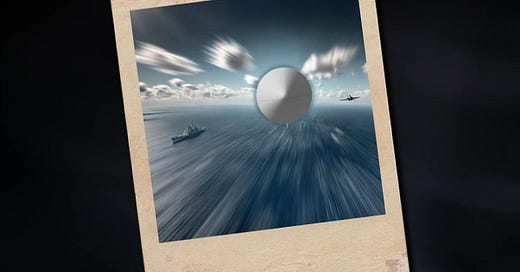In November 2004, an encounter off the coast of Southern California would become one of the most credible and widely discussed UFO sightings in modern history. The U.S. Navy’s USS Nimitz Carrier Strike Group was conducting routine training exercises about 100 miles southwest of San Diego when something strange appeared on radar. The Princeton, a guided missile cruiser equipped with advanced Aegis radar systems, detected unknown aerial objects dropping from 80,000 feet to near sea level in seconds—movements that defied the laws of physics.
Over a period of several days, these mysterious objects repeatedly appeared on radar. They were tracked performing maneuvers no known aircraft could replicate—hovering motionless in high winds, accelerating instantly, and vanishing from view. Concerned and curious, command finally ordered visual confirmation. On November 14, two F/A-18F Super Hornet fighter jets, piloted by Commander David Fravor and Lieutenant Commander Jim Slaight, were sent to investigate.
What they encountered would go on to change how the military talks about UFOs—or as they're now officially known, UAPs (Unidentified Aerial Phenomena). Hovering just above the ocean was a smooth, white, oblong object, about 40 feet in length, with no visible wings, rotors, or exhaust—Fravor described it as resembling a giant "Tic Tac" mint. It appeared to be darting erratically, with movements that seemed more biological than mechanical—responding to the pilots' presence in real time. As Fravor attempted to engage, the craft abruptly accelerated and vanished in less than a second.
Minutes later, when the second flight crew attempted to track the object again, it reappeared—this time on radar—at the exact location where the jets were scheduled to re-enter their training pattern. It was as if the object had anticipated their next move.
What makes the Tic Tac incident so extraordinary is the combination of multiple forms of verification: direct visual contact, radar tracking, infrared footage from a targeting pod (FLIR), and audio from the pilots themselves. The event was documented internally, but remained unknown to the public until 2017, when investigative journalists released the now-famous “FLIR1” video—one of three official Navy videos later confirmed as authentic by the U.S. Department of Defense.
The incident raised urgent questions: If not a U.S. black project or known foreign technology, what was this craft? Its sudden acceleration, anti-gravity-like movement, and apparent intelligence sparked intense debate among military officials, scientists, and the public. Some theories suggest breakthrough propulsion technologies; others lean toward extraterrestrial origins.
To this day, no definitive explanation has been provided. The Tic Tac UFO encounter helped ignite serious governmental interest in UAPs, eventually leading to congressional hearings, intelligence reports, and a growing call for transparency. Nearly two decades later, the mystery remains unsolved—but the evidence is hard to ignore.
Was it a glimpse of classified technology, a surveillance platform from an adversary—or something far stranger?
The sky holds its secrets. And in 2004, the Navy may have caught one on camera.














Share this post